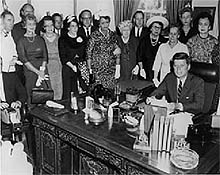 On the 50th Anniversary of The Feminine Mystique, Council on Contemporary Families Scholars identify what’s changed—and what hasn’t.
On the 50th Anniversary of The Feminine Mystique, Council on Contemporary Families Scholars identify what’s changed—and what hasn’t.
In 1963, when Betty Friedan published The Feminine Mystique, “most Americans did not yet believe that gender equality was possible or even desirable,” according to Stephanie Coontz, Council on Contemporary Families Co-Chair and author of A Strange Stirring, a study of why so many women responded to Friedan’s book. Nowadays most people believe in gender equality, but stereotypes still get in the way of acting on those beliefs, as a panel of experts on sex, African American women, marriage, housework, Latina youth, motherhood, and lesbians document in a new online symposium for the Council on Contemporary Families marking the 50th anniversary of the book.
Coontz opens the symposium with four myths about Betty Friedan and feminism:
- THE ANTI-MALE MYTH: Betty Friedan was not a man-hater, and The Feminine Mystique was not anti-marriage. In fact Friedan believed that dispelling the feminine mystique would make marriages happier – and, Coontz claims, she was right.
- THE ANTI-HOMEMAKER MYTH: Feminism has not hurt homemakers. Half century ago, stay-at-home wives had no claim on their husband’s income, no protection against marital rape, and even no right to their own credit card.
- THE CAREER WOMAN MYTH: The entry of women into the workforce and their growing educational advantage over men has not destabilized marriage. Coontz notes that divorce rates have declined since 1980, especially for educated women, who are now more likely than any others to be married at age 40.
- THE POST-FEMINIST MYTH: Women are not yet equal to or ahead of men, so gender equity continues to be an issue. Women still earn less than men with the same educational credentials in every occupation, and more women than men live below the poverty level. In addition, Coontz explains “‘the hottie mystique’ that has led to a sexualization of young girls that can distract them from exploring their new options.”
Additional brief essays offer original perspectives on youth, sex, African American women, lesbians, Latinas, and motherhood.
“The Youth and Beauty Mystique: Its Costs for Women and Men” by Paula England notes that as men age, they have a wider choice of marriage partners, but this can backfire even for men because the younger spouse—whether a man or a woman—is more likely to seek a divorce.
“Sexual Mystiques: Do we still like it old school?” by Virginia Rutter points out that when it comes to sexual fantasies, people continue to be more old-fashioned than they claim to be.
“The UNFEMININE Mystique: Stereotypes about African-American Women” by Shirley Hill argues that black women are subject to an “‘unfeminine mystique’ – the idea that they have characteristics and embrace lifestyles that are outside the boundaries of ‘real’ womanhood.”
“Lesbian Mystiques” by Judith A. Howard recognizes the remarkable change in the status of gays and lesbians in the past 50 years. Once invisible —or even condemned, including by Friedan—lesbians have not only won new public acceptance but have broadened their own self-images and definitions.
“Latinas’ Mystique” by Lorena Garcia, explains her study of Mexican American and Puerto Rican adolescents, Respect Yourself, Protect Yourself: Latina Girls and Sexual Identity, and the distorted image of how much impact culture influences girls’ lives.
“The Rise of the Motherhood Mystique” by Cameron Macdonald draws upon her research for Shadow Mothers; Nannies, Au Pairs, and the Micropolitics of Mothering to explain “Today women’s work outside of the home is often necessary and desirable. But we are a long way from the gender equity Friedan advocated. A new Motherhood Mystique has replaced the Feminine Mystique. Where the marital relationship was the core of the family unit in the 1950s and 1960s, today the mother-child bond is primary.”


 What’s the big deal about uptalk? In The College of William & Mary’s
What’s the big deal about uptalk? In The College of William & Mary’s  The
The  My colleague
My colleague  My colleague
My colleague Just about the most mundane thing to populate media lately has been the claims of the end of men. Even so, two weeks ago, I attended a useful conference at Boston University Law School on “
Just about the most mundane thing to populate media lately has been the claims of the end of men. Even so, two weeks ago, I attended a useful conference at Boston University Law School on “ Mary Wollstonecraft
Mary Wollstonecraft Two amazing young gender and sexualities scholars stepped up to offer a column this month on what I have dubbed “the real BDSM.” Heidi Rademacher and Suzan Walters are PhD students in sociology at Stony Brook University. Heidi has an MA from Brandeis in sociology and women & gender studies; Suzan has an MA from St. John’s University. They are working on a longer critique of the Fifty Shades of Grey trilogy that explores women’s experiences with BDSM, and offer this preview. Now to Heidi and Suzan on BDSM:
Two amazing young gender and sexualities scholars stepped up to offer a column this month on what I have dubbed “the real BDSM.” Heidi Rademacher and Suzan Walters are PhD students in sociology at Stony Brook University. Heidi has an MA from Brandeis in sociology and women & gender studies; Suzan has an MA from St. John’s University. They are working on a longer critique of the Fifty Shades of Grey trilogy that explores women’s experiences with BDSM, and offer this preview. Now to Heidi and Suzan on BDSM:  The end of the baby boom years is identified variously as 1960 all the way to 1964. This means that while the lead-end of baby boomers are hitting 65 around now, at the tail, where I am, I’m flooded with fiftieth birthday events. Aging, anyone?
The end of the baby boom years is identified variously as 1960 all the way to 1964. This means that while the lead-end of baby boomers are hitting 65 around now, at the tail, where I am, I’m flooded with fiftieth birthday events. Aging, anyone? 